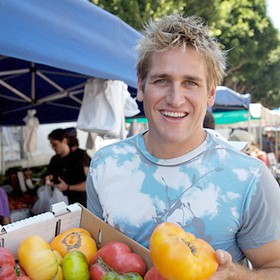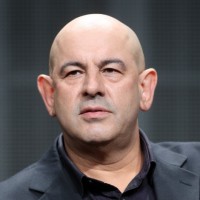EAT: THE STORY OF FOOD – Famous Chefs & Foodies Talk Favorites + Food Fun Facts
Maj Canton - November 20, 2014

How did Spam help defeat Hitler? How did sausage spread the Roman Empire? How will climate change affect the food we consume in the future?
EAT: THE STORY OF FOOD answers these questions and more. In Nat Geo's six-part, three-night series, nearly 70 chefs, authors, food experts and food scientists share their personal stories, while discussing their perspectives on the past, present and future of food. This series marks the first time a show has ever looked back at when we ate what, why we ate it, and how it's made us who we are.
To get you ready for this new series, we're going to start you off with the favorite meals and junk food of these famous foodies. Then, for the main course, these food experts share their thoughts on the importance of food and its future. For a little treat, we have five "Did You Know..." fun facts from the series. Finally, we finish it off with a sneak-peek video of the new series. Just keep reading to find out more about your favorite chef or culinary writer.
EAT: THE STORY OF FOOD premieres tomorrow (Friday, November 21, 2014) at 9pm ET/PT on Nat Geo, airing from 9-11pm nightly through Sunday, November 23.
|
|
|
|
| FAVORITE MEALS | |
|
Nigella Lawson in EAT: THE STORY OF FOOD |
Michael Pollan, author: Great French fries are pretty damn good. |
|
Marcus Samuelsson, chef: My favorite recipe is my grandma’s meatballs because it’s really the start of cooking for me. I would not have become a chef without my grandma’s meatballs. It was not just when we ate them we loved them, but it was also the whole procedure of making them. It was something that taught me respect in the kitchen. |
|
|
|
|
|
|
|
|
| FAVORITE JUNK FOOD | |
 Eric Greenspan in EAT: THE STORY OF FOOD |
Eric Ripert, chef: I do have a favorite junk food. If we consider gummy bears junk food, I eat junk food. |
| Roy Mitchell, pitmaster: My favorite junk food would be a good hot dog. I love a good hot dog. Anna Boiardi, great-grandniece of Chef Boyardee: I love popcorn and I love potato chips. I definitely love salty, crunchy snacks. But in my time, I’ve certainly eaten my fair share of Oreo cookies. Simon Majumdar, author: I am addicted to salted peanuts. I just, I love salt. Salt is probably one of the reasons why I'm already on blood pressure medication. Ching He Huang, chef and television host: If I had to serve junk food to my group of friends, whether it's watching football or watching a movie or just catching up, it would have to be pizzas and beers. |
|
|
|
| ON THE IMPORTANCE OF FOOD | |
|
Graham Elliot in EAT: THE STORY OF FOOD |
Ruth Reichl, food writer: I think food is what brings us together as a community. We all eat at least three times a day. It is the one thing we all have to do. And since we have to do it, it seems to me that it behooves us to do it with as much care and thought and dignity as we possibly can. |
| Padma Lakshmi, television host: When we court each other, when we are celebrating a marriage, when we are celebrating a birth, when we are burying our loved ones. What do we do? We bake a casserole. We ask someone to dinner. We plan the wedding buffet. Every major event in a human being’s life is centered around food in some way. Nathan Myhrvold, author: Cooking at one level is a science experiment. It’s the only science experiment people routinely perform at home. You can actually make stuff. |
|
|
Marcus Samuelsson in EAT: THE STORY OF FOOD |
Noah Fecks, author: I think eating is one of those things that’s a human requirement, but it’s the one thing you have control over. You’re not making your own clothes, you’re not building your own house. You’re making your own food. |
|
|
| ON THE FUTURE OF FOOD | |
|
Simon Majumdar |
Simon Majumdar, author: I think one of the things we need to think about food is that we’re caretakers. You know, we don’t own the world, we’re caretakers for the next generation, the generation after that and we have to teach good practices to our children as well. |
| Nicola Twilley, author: What I would like to see in the future is humans using more of the 250,000 edible plants that we don’t consume. We could expand the flavor palate that is open to us by an awful lot just by eating more than just 150 or 200 different plants, which is what we limit ourselves to right now. Barton Seaver, chef and National Geographic Society Fellow: I would love to see the meat of the future be more vegetables on a plate. We’re never going to move away from a meat-based culture, but I think the real success will come from just shrinking the portion size of meat. Paul Josephson, professor: I’m not optimistic about the future of nutrition in the United States, and there is one major reason. Congress and the food industry are working hand in hand. They claim to be protecting the public health, but what they are trying to do is to increase the output of food and increase the profit level of those industries. Let’s put public health first. Dan Barber, chef: Part of the challenge for the future of seafood and the future is to change the culture around how we enjoy seafood. It’s the same thing with how we enjoy meat. We’ve got to listen to what the ecological conditions are telling us it wants to grow in the field, and we’ve got to listen more towards the ecology of the ocean. |
|
|
|
| DID YOU KNOW... FUN FACTS FROM THE SERIES | |
 |
How Spam Saved the Russians: A few years after Spam hit shelves in 1937, Hitler plunged the world into war. Food was rationed. Everyone had to make sacrifices. Nylons, coffee, cigarettes, basic necessities were in short supply. But in the U.K. and the Soviet Union, there was plenty of Spam. Nikita Khrushchev said, “Without Spam we wouldn’t have been able to feed our army.” Since the 1930s, this gelatinous throwback has sold more than 6 billion cans — and it’s still selling. In fact — Americans eat, on average, 2.8 cans per second. |
| Let Them Eat Caviar: Believe it or not, there was a time when sturgeon were so plentiful that caviar was served as free bar snacks on America’s shores, similar to nut bowls put out in your local pub today. It was salty, made the regulars thirsty, and so they bought more beer. By the end of the 19th century, however, the overfished sturgeon virtually disappeared from the rivers of Europe and the Americas. As demand outstripped the dwindling supply, the price of caviar doubled between 1900 and 1915, making it the luxury item it is today. Paid in Carbs: In ancient Egypt, there were jobs to be had — building pyramids. While it might not sound so great by today’s standards, skilled workers could have a job for life, as it could take 20 years to build one pyramid. And at the end of a long day, they’d get their version of a paycheck — bread and beer. The use of bread and beer as wages or currency meant that they became synonymous with prosperity and well-being. Egyptians identified themselves so closely with the necessities of life that the phrase “bread and beer” was also used as an everyday greeting, much like wishing someone good health. How Lobster Got Fancy: Ask anyone, and 9 out of 10 people will list lobster as a favorite food. But that wasn’t always the case — in fact, far from it. Until the 20th century, it was most commonly thought of as trash food, only fit for the poor and fed to servants, prisoners or farm animals. Until, that is, train managers had a realization — club cars could serve it to passengers unfamiliar with the creatures, as a rare and exotic item. The Santa Fe Railroad and others would load up with lobster at the coast where it was cheap and serve it once they hit the Midwest. Passengers didn’t know they were eating the ocean’s equivalent of hot dogs, loved it and began to ask for it even after they left the train. Thus began lobster’s transformation. The Candy That Couldn’t Taste Good: In April 1937, U.S. Army Capt. Paul Logan presents Milton Hershey and his Chief Chemist Samuel Hinkle with a bizarre order for candy bars, with very specific requirements — they must weigh no more than 4 ounces, must resist high temperatures and, most important, can’t taste good. These candy bars are designed to be the soldier’s last line of defense — a food of last resort when literally nothing else is available. So the army has to make sure troops won’t be tempted to eat them unless absolutely necessary. Hershey delivers and the D-Ration bar is detested, so much so that troops call them “Hitler’s secret weapon.” But although the U.S. troops can’t stand them, D-Rations become America’s iconic good-will gesture, handed out to hungry civilians all across war-ravaged Europe. |
|
|
|
Here's a sneak peek of EAT: THE STORY OF FOOD, which premieres tomorrow (Friday, November 21, 2014) at 9pm ET/PT on Nat Geo, airing from 9-11pm nightly through Sunday, November 23.
|
|
Plus, here's the first of a series of seven videos during which celebrity chefs and authors discuss the importance of food. (Click on 'Play All' to see all videos in a row.)
|
|





